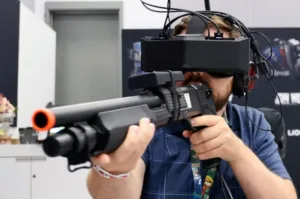Road to VR‘s Ben Lang spoke to Emmanuel Marquez, CTO of Starbreeze VR, at E3 this month. We first began covering the firm about a year ago, when its HMD became famous for its massive field of view (StarVR More Than Doubles Oculus FoV). Starbreeze’s latest StarVR 1.4 prototype has a 210° FoV.
One of the points raised was specifically about the display. Although the StarVR enjoys a wide FoV, it does not yet have low persistence (which reduces blue during head movement). Marquez said that this is a priority, adding, “[W]e’ll have that ready pretty soon.”
Starbreeze is working on its own tracking system, rather than using Sixsense STEM (third-party) that it is currently utilising. This will be different to Oculus VR’s or Valve’s implementations. Marquez said that the Starbreeze system would be an “outside-in” approach and its range “may” exceed roomscale (around 1.1m²).
A tracker would be attached to different props, as required by the content – in this way it sounds similar to Sony’s Playstation Move or the Wiimote. For more universal experiences, however, Starbreeze is building its own VR controller.
Image: Road to VRIn addition, Marquez told Lang that eye tracking will be integrated in the finished product. This will be used for features like foveated rendering (rendering only the areas where the eye is looking in high resolution, with other parts of the image becoming progressively more blurred towards the edges of vision – a memory and processing-saving tool). Foveated rendering would be especially attractive for StarVR, which boasts 5k (5120 x 1440) resolution; this uses a lot of computing power.
Finally, Marquez described the intended application area for the StarVR. “[F]or the moment we play pretty firmly in the location-based and enterprise market,” he said, adding that there were currently no plans to create a consumer version.

